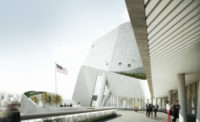A Salt Shed for Spring Street






The creation of miles of parkland along the west side of Manhattan hasn’t come cheap; to make way for benches and bike lanes, the city has had to relocate Sanitation Department facilities that had faced the Hudson River. That decades-long task has now resulted in an architectural gem: a municipal salt shed in the form of a shapely concrete container that is winning rave reviews — even from people who have no idea what it’s for. (Honestly, a visitor to New York could be forgiven for thinking the salt shed, with a sculptural exterior that rewards repeated examination, was the new Whitney Museum, and the Whitney Museum, with its utilitarian skin, was the new salt shed.)
The so-called shed — really a seven-story enclosure designed to hold 5,000 tons of salt — is an adjunct to a massive sanitation department garage designed by Dattner Architects and WXY Architecture & Urban Planning.
That building, which contains parking for 150 garbage trucks, plus offices and other facilities, has a louvered south facade that is surprisingly successful at camouflaging its bulk. But the department also needed a place where its trucks could stop to pick up salt in winter. As it turns out, the resulting shed, immediately south of the garage, serves as a kind of public sculpture, mediating the scale of the much larger building, the function a Calder or Picasso sculpture might perform for an office tower uptown.
The building’s success was far from assured. Originally proposed a decade ago, it could have been a prefab structure made for storing salt. But TriBeCa is a neighborhood with lofty aspirations (a where a new condo tower by Herzog and de Meuron is only the latest architectural bauble). When the community opposed a salt shed that looked like a salt shed, the Public Design Commission, which reviews construction on city property, stepped in. One of its members, James Stewart Polshek (whose predecessors on the commission have included Charles McKim, Hugh Ferriss, and Wallace K. Harrison) challenged the architects (the team of Dattner and WXY, with Dattner eventually completing the design) to come up with something special. And he challenged the city to come up with the money to pay for it. According to Gia Mainiero, Dattner’s project manager, “Polshek really changed the assignment.” (The eventual budget was $20 million, many times more than an off-the-shelf salt shed would have cost.)
Working in BIM, the architects created a building envelope said to resemble a salt crystal (which is a bit of a stretch, an unnecessary bit of form-follows-function myth-making, given that salt crystals are cubes). The finished building is essentially one large room, enclosed in concrete walls that are six feet thick at points. An opening at the east side of the building (alongside an art deco Holland Tunnel air vent) allows trucks to move salt in and out while largely hidden from the street.
For Dattner, who founded his Manhattan firm 51 years ago, September has been a month of triumphs. Just days before the unveiling of the salt shed, a project of the city’s Department of Design and Construction, the city opened a new subway station at the edge of the burgeoning Hudson Yards development. The station, designed by Dattner, with a glass entrance canopy by Toshiko Mori Architect, is a marvel of efficiency, and at times even elegance. These days, New Yorkers can be proud to feel like the salt of the earth.





